Spellbound Kingdoms by Nifara
WELCOME AND CORE MECHANIC
Original SA postSPELLBOUND KINGDOMS PART 1: WELCOME AND CORE MECHANIC
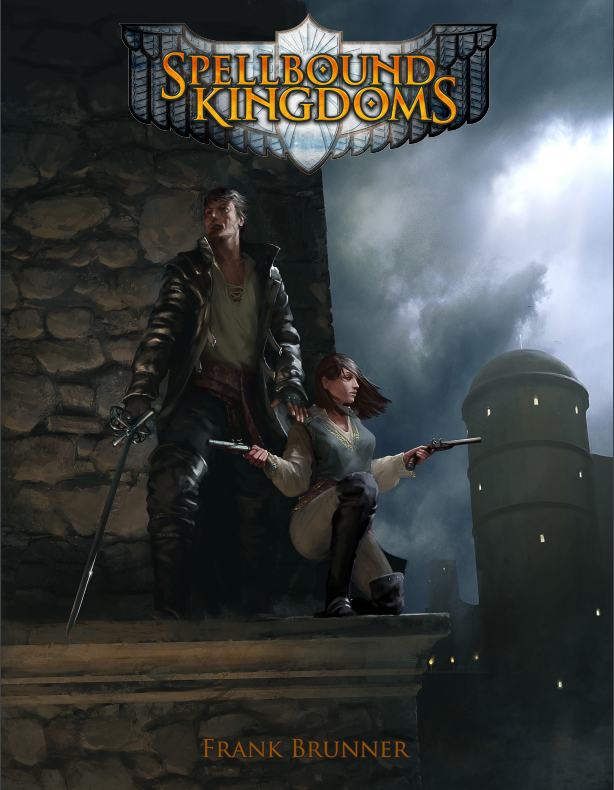
That's a pretty nice cover. I like that cover.
The thing to note there is the bit at the bottom: Frank Brunner. That's not just him showboating, oh no.
Spellbound Kingdoms posted:
Design, Writing, and Layout: Frank Brunner
There's no doubt about it: Spellbound Kingdoms is one guy's fucking obsession. Games like that are sometimes just masturbatory heartbreakers, but occasionally it means you just get one very cohesive vision (hint: that’s what this is).
He used to work for Wizards of the Coast, writing supplements for D&D back in the 3.5 era, but according to one interview he left because he was frustrated at having his work cut back and mucked around with – “I decided I was tired of my baby’s arms being torn off”.
Reading the book, he’s got a point. Wizards should have just let him done his thing because holy shit, this is gold.
It opens with a welcome text, and you’re immediately dropped into the thing I probably like least about the game – the incredibly casual way in which it’s written. He’s clear about the rules (most of the time), but everything else is done in this really chatty style, often with interjections about how the game isn't very good. It’s frustrating, because the game is actually really good, and having Brunner tell me every other page that it sucks just annoys me. Take some damn pride in your work.
He does, however, also cover some useful stuff in the welcome. He points out that his game doesn’t do things that a lot of other games do, and there’s a bunch of stuff people might not expect to find in it. Usually this is just pretension, but actually he’s not wrong. When he says there are “integrated culture, war, shadow war and economy rules”, he really means that.
He also talks about how the layout to the first edition was shit, and he’s tried to make it less shit this time around, but it’s still kinda shit. For fuck’s sake Brunner, have some god-damn pride.
He also drops the obligatory rule zero bullshit that games tend to fall back on, and that does annoy me, and it’s weird because reading over the whole text it’s clear that he’s made a decent effort to genuinely handle 99.9% of issues you might have. He kinda doesn't need rule zero.
There’s also a note about materials you need (all the polyhedrals and notably copies of the “fighting styles”), and then a note saying “I think you know already know what an RPG and a GM is, so skip that. Otherwise, fucking Google it (seriously, that’s what it says).
Now we hit the first proper section of the book – chapter one: rules.
It opens with a sort of odd discussion of the artwork for the chapter, explaining what it is, what it means, and explaining that it’s the kind of thing the game is looking to support. It's this bit of artwork:
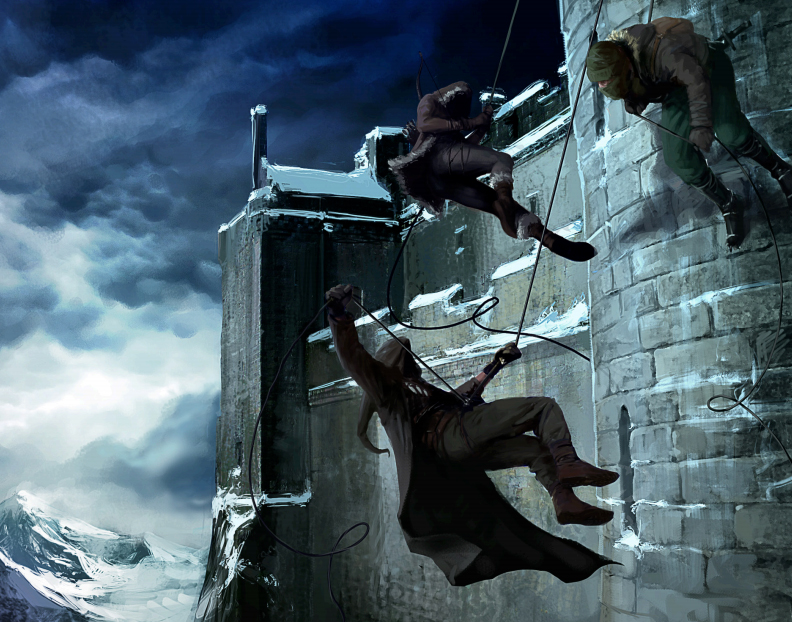
Like, that's cool and all, but it's a bit weird to spend the opening paragraph of your rules chapter talking about your artwork. He goes onto say that it represents what he wants out of a game which is to
Spellbound Kingdoms posted:
drive the game at a fast pace and set it on a collision course with the most dearly held inspirations of PCs and NPCs. If lovers are riven, homes are burned, and true love conquers all, then you are playing the game as it was meant to be played.
That's a pretty ambitious brief.
Next up is an overview of the core mechanic , which is basically roll over the target number, with different polyhedrals to represent different levels of ability. He also calls out inspirations, that work a bit like action points, but are represented in the world directly – so if someone kills your wife, you get worse at sword fighting.
That’s the first time that Brunner explicitly calls out what ends up being a major theme of the game, because that’s not an out of character metagame conceit. That’s in character and in world. People know damn well that if your wife gets murdered you’ll be worse at sword fighting – until you shift your personality around enough to use “get revenge on the fucker who killed my wife”.
Spellbound Kingdoms is also weirdly a dice pool system. Basically, when you roll to do something, you might end up rolling several dice, each for a different thing (one because I’m strong, one because I’m a skilled sword fighter, one because I love my wife, that kind of shit), and you get to roll all of them. But you don’t add them together – instead you take the highest result off all the dice you rolled.
Dice also explode, but not in the way they do in lots of other games: if you max out a die, you roll the nice die step up as a new die in the pool, but you still only pick the highest number out of all of them. If you think that rolling a 12 on a d12 sounds fucking broken, well, Brunner thinks you might think that:
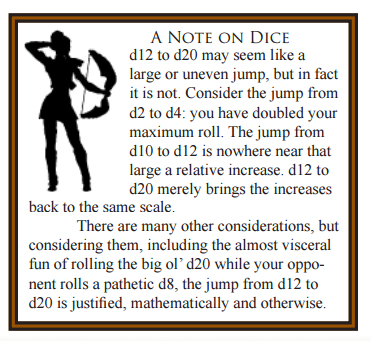
The thing is, he's not wrong. Rolling a d20 in this game is more satisfying than it ever was in years of playing D&D, whatever edition. You know when you break out that d20 it's time for someone to be your fucking bitch.
What polyhedral you roll is basically the biggest one you can “fit” into the number of the attribute, skill or whatever. If it’s a 7, you roll a d6. If it’s an 8, you roll a d8.
Modifiers are basically advantage and disadvantage from D&D 5th – you roll a bonus die in your pool for a positive modifier, or you roll a bonus die in your pool and take the lowest value for a negative modifier. That makes penalties pretty fucking brutal. If you have both penalties and bonuses, you get to roll the bonus die last and so it’s not all lost.
If you tie on a contested check, the higher die type wins. If they’re the same, reroll. Contested checks are just two people rolling off, but that’s not how most checks are made. Most are made against the doom.
The doom is measure of… well, I’ll let Brunner explain it, because it's another one of those moments where it's not clear right away that this isn't just a concept for the players, it's a concept for the characters. In-world stuff later in the books talks about the doom as if everyone knows about it.
Spellbound Kingdoms posted:
On the other hand, if you are rolling against the environment, the target number is usually the Doom of the region. The Doom is born of magic, the king, and fate. It measures the difficulty of life. Woe and misery walk in lands with high Doom, while the sun shines warmer, and there are fewer children wailing from plague-flagged tenement windows, in lands with low Doom. Doom opposes heroic actions; a peasant need not roll against the Doom to cook lunch.
From a game design point of view, the Doom is an aid to the GM. Instead of feeling forced to come up with difficulties or target numbers on the spot, the GM uses the Doom.
That's right, in this game, people have come up with an objective measure for how shitty your town is. And that directly impacts on whether you can swing on a chandelier and kick someone in the face. Because plague-ridden children being miserable outside makes your swashbuckling nonsense harder.
This ain't anywhere near the extent of how weird this idea gets. Buckle up, because next time we're going to talk about how really hating a motherfucker or how being an obsessive stamp collector can make you immortal.
Next up: MOOD, INSPIRATIONS, FEAR AND BEING FUCKING IMMORTAL AT FIRST LEVEL
MOOD, INSPIRATIONS, FEAR AND BEING FUCKING IMMORTAL AT LEVEL 1
Original SA postSPELLBOUND KINGDOMS PART 2: MOOD, INSPIRATIONS, FEAR AND BEING FUCKING IMMORTAL AT LEVEL 1
So the core dice mechanic is pretty simple to get to grips with, and pretty cool, but it doesn’t explain much about how the game works unless you put it in the context of mood and inspirations.
So mood is a measure of your character’s… uh, well, mood. It’s how happy they are, how engaged, how much energy they’ve got and how much they can handle giving a shit right now.
Mechanically it’s half action point (you can spend mood to max a die, but not let it explode) and half health (you can spend it one-for-one to absorb damage). It’s a strange conceit, but as we head more into the way the setting works, you’ll see it makes sense.
So how do you get mood? Well, you get some to start off, and after that you get it by:
- Winning a social attack and choosing to feel good about yourself rather than making your target feel like a dumbass
- Doing crazy swashbuckling bullshit in combat, like swinging from chandeliers and smashing through windows to duel a moustache-twirling evil Duke
- Getting shit from class and talent bonuses
- Spending time getting drunk, going for a nice walk, taking time out to be with your family, and basically whatever else makes your character happy. That does mean that if you have a massage before a battle it’ll be harder to kill you, especially if it has a happy ending. Those aren’t words I thought I’d ever write.
So, inspirations. I’ll let Frank take this one:
Spellbound Kingdoms posted:
This is a world where love and fear hold dominion even over death. Inspirations drive the architect to build, the lover to woo, and the warrior to fight. They move the world, and they have the power of magic. For all of these reasons, the nobles condition the commoners to accept a life of blandness and to settle for tepid passions. Inspirations are far too dangerous for just anyone.
Oh yeah, he’s not bullshitting with this, and it’s the first clue that the setting of Spellbound Kingdoms, despite the fact that you play ridiculous swashbuckling insult sword fighters, is super dark. Like, concentration camps and secret police dark. The nobles are all over that inspiration shit, and they want to stamp it out as much as possible. That means forcing people to lead as drab and miserable lives as possible, and making them do stuff they don’t care about all the time. We’ll get more into that later, but honestly that’s the difference between heroes and everyone else. Heroes aren’t any more skilled or talented, they just give more of a shit.
So mechanically, each inspiration can be used once a scene to roll a bonus die on a check. If the inspiration actually applies to the situation, that’s called “stunting”, and you can maximise that bonus die, and the main die in your original check, and they both explode. Caring about stuff is OP as fuck in this game.
Each inspiration gets a rating, but that rating doesn’t let you use them any more often. Instead, it makes them more important to you, and that protects them - when you run out of mood, people can try and convince you not to care so much about your inspirations, but there's more not caring you have to do to lose them if they're higher rated. Equally, if they do something to fuck over your inspiration, then it can get “damaged” or even just taken away.
The other thing that high-rated inspirations do is make you unkillable.
That’s not hyperbole, here’s the rules verbatim:
Spellbound Kingdoms posted:
Love and fear are the most powerful forces in the world. Where there is love, death has no dominion, and where there is fear, peace finds no purchase. Inspirations can change the world.
You have already seen how Inspirations can act as action points. They can do more: they can save a character when nothing else can.
If a character has a Love with a value of 3 or more, she cannot be killed or indefinitely removed from play except by natural causes. If any other inspiration has a value of 4 or more, the same is true.
Love, Fear, and other inspirations are the masters of fate in the Kingdoms.
You read that right: if you love something enough, your character can’t die. However stupid and improbable it is that you’ll survive, love will find a way. We’re not screwing around here:
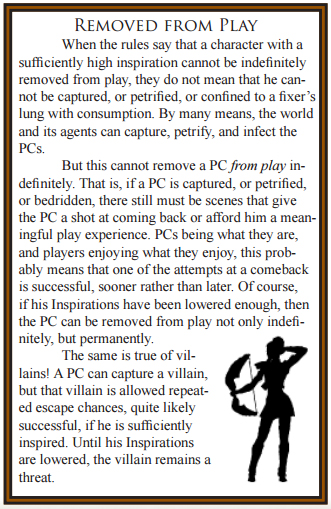
But that’s not just soppy romantic love, oh no. Love fucking killing people enough? Now you’re immortal. Is there a good reason why you, as the wizard, should not take Love of Magic at 3+?
No, no damn reason at all. You 100% should.
If 90% of the party aren't immortal at character creation you’re probably playing the game wrong.
On the other hand, the person who takes lots of inspirations all rated at one is going to be terrifying, because they can use inspiration a lot more. It’s one of those things that, actually, works really well as a balance. You can give up being absolutely sure of your character’s survival to give them more screen time and make them more effective.
Fear is the last thing in this section. Fears are basically negative inspirations - they’re things you care about because, well, they scare you. In effect, it’s really easy to pick up fears in play, and they work just like inspirations (yes, that does mean if you’re scared enough of something you can no longer be killed). If you decide you’re actually super scared of being robbed by muggers, boom you've got a new inspiration on your sheet. The downside is, if you come face to face with your fear, then you’re screwed, and you get penalty dice shoved at you from every direction.
There’s a limit on the total number of points of inspirations you can have, which is probably a good thing.
It’s worth thinking over the whole “inspirations can make you immortal” thing a bit more though:
In a world where loving your wife enough renders you unkillable, and, explicitly, everyone in the setting knows that, assassinations play out a bit differently. You can’t just beat the Duke in a sword fight and kill him - he’ll survive, 100% guaranteed, because he really loves his wife.
So how do you get around that?
Well, you could either subtly undermine him, make it seem like his wife was unfaithful, destroy his belief in the institution of marriage, and generally bum him the fuck out until he’s miserable, inspirationless, and then run him through.
Or you could kidnap his wife, torture her and murder her, and then shoot him through the head.
Both of those are valid tactics.
It also makes the Assassin class the scariest damn thing in the game, because at level 10 they get the ability to actually just kill someone regardless of their inspirations.
Next up: SKILLS, HISTORIES AND CLASSIC VS SCENE ORDER PLAY
SKILLS, HISTORIES AND CLASSIC VS SCENE ORDER PLAY
Original SA post SPELLBOUND KINGDOMS PART 3: SKILLS, HISTORIES AND CLASSIC VS SCENE ORDER PLAYSo we’ve seen how inspirations can give a character some dice, but where do the rest come from? The answer is characteristics (which we’ll come onto later) and skills and histories.
Skills and histories are basically just measures of your character’s learned ability to do stuff. The terms are used pretty interchangeably, and in practice most of them are really histories - snippets of your past experience that give you an idea of the kind of tasks that your character would be good at. A history might be something like Tomb Robber for the Rithaign Factors, Haulers and Panhandlers. That history would let you roll the appropriate die (considering its value) when trying to do anything related to robbing tombs or interacting with the Rithaign Factors, Haulers and Panhandlers (a group from the setting that’s basically a thieves’ guild).
It’s a cool idea, and cooler still because in play between levelling up you get experience in the form of history points… that you should spend on a history that describes what you were actually doing in that session, or on a history that you’ve “increased” by playing to it heavily. The book also encourages you to tweak your histories as you play, so you might start out with one that says Ran away to sea and then replace it with Able hand on the good ship Pentaghast and then eventually with Mighty pirate and veteran sailor. It allows you to really feel like your character is being directly impacted by the events of the game.
The bad in this section is that it’s just not clear enough about what is an acceptable history and what’s not. It says “the GM and the group must accept your skill phrasing”, but there are very few examples given, and no good guidelines drawn. It’s probably the bit of the game most open to abuse… or just misunderstandings. With a few more paragraphs of detail, and some better advice on how to word them, this would just be an awesome thing. As it is, it’s an awesome thing with some big flaws.
One important note is that histories can’t aid combat rolls or magic rolls. That sounds a little strange, but we’ll see in a future part of this review why that’s the case.
Brunner next outlines one of first big choices anyone playing the game will need to make: whether to opt for classic or scene order play.
Basically classic play unfolds like most other RPGs do - time passes as you do stuff, things happen in a chronological order for the most part and play has a recognisable rhythm to it. Scene order play is… not like that.
If you’ve played a White Wolf RPG you’ll probably recognise some of the concepts that Brunner explains in this section: instead of play just progressing organically, it instead takes place in scenes which have delineated beginnings and ends. Spellbound Kingdoms pushes the concept much further than White Wolf ever did, though.
In scene order play, the GM and the players take turns presenting scenes. Whoever’s presenting it outlines what it’s going to be about, and what they want out of it… and who is in the scene. It makes the group much more of a collaborative partnership, with control over your character not being solely in your hands. It also relies upon the players being just as aware of and in control of the story.
I can totally see why you might want to play like this (it reminds me strongly of Dramasystem and I like that game a lot), but even though I’ve known it’s an option, I’ve never played or run a game of Spellbound Kingdoms using it. It’s a cool collaborative idea, but it’s just not one that appeals greater to me. Brunner covers the subject in some depth, and reading his guidance I’d feel comfortable running it like that… I just don’t want to.
Next up: COMBAT
COMBAT (STYLES, MANEUVERS AND INITIATIVE OPTIONS)
Original SA post SPELLBOUND KINGDOMS PART 4: COMBAT (STYLES, MANEUVERS AND INITIATIVE OPTIONS)Brunner introduces the combat chapter in his usual chatty style:
Spellbound Kingdoms posted:
Blade, pistol, and fist all have their place in combat, as do falling sandbags, eggshell grenades soaked in flake spores, and the most unpredictable destructive force of all, magic. No matter what your combat style is, clear tactical thinking is vital.
Part of that tactical thinking is the decision when to use Mood and Inspirations. Combat is so fast that the next round can start before a player realizes that he should have used a Mood or Inspiration last round. Don’t be that player!
Another large part of the tactical thinking is the choice of fighting styles and maneuvers within those styles, as we shall see.
He then launches into an overview of how combat works. Basically, every character has access to one or more fighting styles, which range from free sword (classic fantasy sword combat) to swashbuckler (which involves lots of swinging on things and spouting insults) to more unusual fare like dagger and wine (which is half sneak attacks and half destroying your enemy’s morale with nasty secrets).
Fighting styles are made up of a number of different maneuvers - specific moves you can make that have different effects and let you do different things. But you can’t just choose maneuvers freely - you have to work your way through the styles like combat styles. Here’s what free sword looks like:
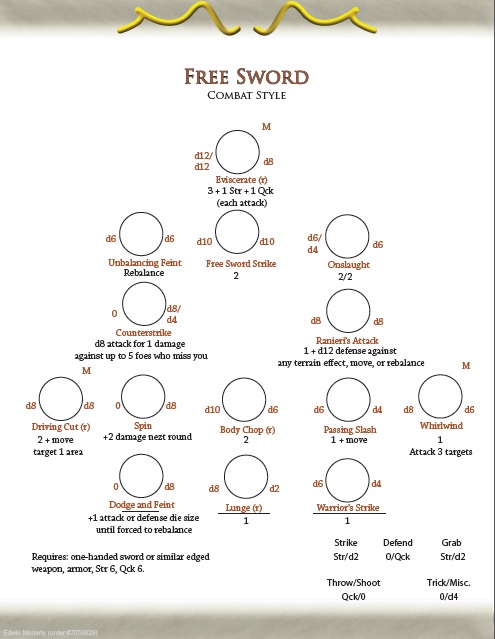
Let’s drill down a bit before we talk about how the styles themselves work as a whole, and look at a maneuver on its own. Here’s Dodge and Feint:
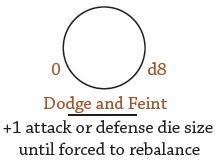
The number to the bottom left of the circle is the attack die - in this case it’s zero because you don’t actually get to attack when you perform this maneuver. The number to the bottom right is the defense die, which you roll to contest any attacks made against you in the round of combat when you’ve selected this maneuver. d8 is pretty good, making dodge and feint, as you’d expect, a good defensive choice.
The underline indicates that this maneuver is a balancing maneuver. That means that you can open up a combat in it, and when you’re forced to rebalance (some moves for your enemy to rebalance, and some make you rebalance) you can select it as your next maneuver. Once you’ve selected a balancing maneuver, on your next turn you can move to another maneuver, as long as it’s in line with it, and you’re not jumping over any gaps. So from dodge and feint I could choose: spin, counter strike, unbalancing feint, lunge and warrior’s strike.
The line underneath the name of the maneuver tells you what the maneuver does - there are more in depth guides to what each maneuver actually does if it’s not clear. Most of them do some amount of damage (which depletes your body, or if you spend mood gets absorbed by that). In this case, dodge and feint makes your attacks and defenses better until you’re forced to rebalance.
Alongside the more mundane combat styles, you’ve also got magic styles. Every type of magic (and we’ll look at that more later on) has a style sheet to go alongside it. That means you can use every type of magic in the game in combat, and they’re super cool. Magic styles have a very different feel - they tend to have a lot more wind up than combat styles, but a big pay off when you get through the process. So, here’s Death Lore:
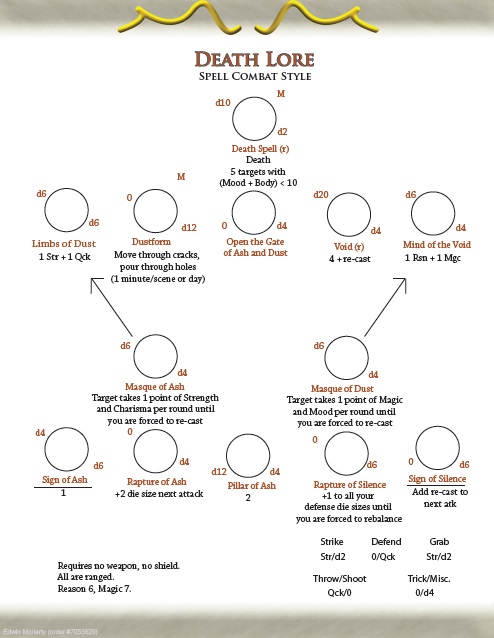
And here’s Death Spell, the pinnacle of that style:
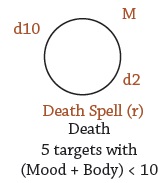
The M means this is a mastery maneuver - you can only use it if you’ve mastered the style. The ability to use a combat style comes in one of three levels: neophyte, apprentice and master. Neophytes can only use the balancing maneuvers and three others, apprentices can use all of them except the master maneuvers, and masters can use all of them.
The (r) means that you have to rebalance after performing the maneuver.
If there are dice in the top left or right that means that they have magic attacks and defenses - which circumvent mundane defenses and can defend against magical attacks.
So, to recap: everyone knows some combat or magic styles, and in combat you broadly pick maneuvers off of them with some restrictions of which ones they take and when. That’s pretty much the basics, and the styles themselves are awesome. They’re extremely pleasing to use (my groups have had minis or tokens to keep track of where they are), and for the GM they’re incredibly quick and easy to use - if you’re running 8 antagonists in free sword, you just need the one sheet and 8 numbered tokens.
Initiative has a couple of options: duel and traditional. Traditional is a standard initiative order - you all roll, and then act one at a time in order. We tried it, and it’s fine, but honestly it misses a lot of the excitement of the styles.
In duel initiative, you all pick the style you want and then reveal them all at once. You then resolve the effects simultaneously. That works brilliantly in practice, and makes the whole thing feel very tense and exciting. One on one duels are great fun, but actually group combats work as well - the whole thing breaks down into little back and forths, and there’s a lot of cool tactical stuff to do with anticipating your enemy.
The styles are one of my favourite things about the game, and there’s a lot of variation. In total there are about 40 styles in total, some of which are only for enemies. Dragon is terrifying:
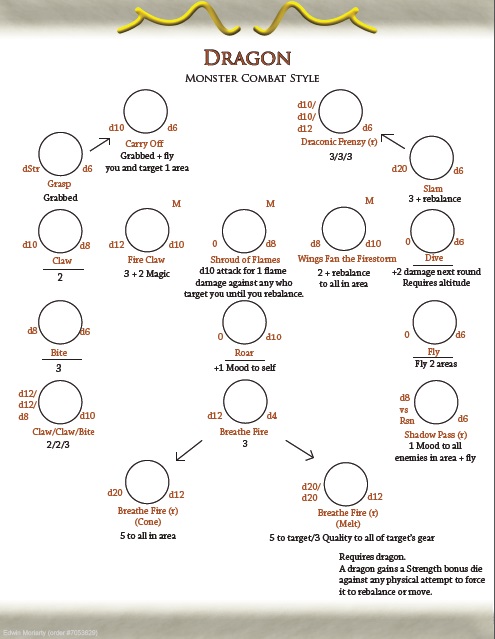
Next up: COMBAT (MOVEMENT, ENVIRONMENTAL TRICKS, GEAR AND THE REST)
MOVEMENT, ENVIRONMENT TRICKS, GEAR AND THE REST
Original SA post SPELLBOUND KINGDOMS PART 5: MOVEMENT, ENVIRONMENT TRICKS, GEAR AND THE RESTWhenever you want to do something that isn’t a maneuver on your style, whether that’s move around the location the combat is happening in, switch to a different style or just do something not listed, you need to do a miscellaneous action, or trick. Tricks force you to rebalance afterwards (unless you’re doing another one right away), and they can disrupt the flow of your fighting, but sometimes they’re essential.
Movement doesn’t work in fixed lengths, but rather abstractly. The location of the combat is divided into areas in a qualitative fashion, and this is broken down with some examples:
Spellbound Kingdoms posted:
the library, the balcony, the space inside the giant cake before the royal chef’s birthday feast.
Moving around inside an area is free, and you do it just through description. Moving between areas requires an action (one action moving one area), and though some styles have movements as the effect of some maneuvers, mostly you’ll be using tricks to move about. In duel initiative, just to keep everything functional, you can be attacked in both areas of your movement, but you can only attack in the area to which you’re moving.
In play, we rarely found we needed a map to play, and when we did it was just a rough sketch so everyone could fix the layout in their minds. It’s very simple, but with the meat of combat sitting with the styles, it’s nice not to overcomplicate matters when it comes to movement.
Environment tricks are the other kind of trick you’ll probably do a lot in a combat in Spellbound Kingdoms. They’re special actions that involve the scenery, with the recommendation that the good ones should destroy bits of the scenery in doing them. Environment tricks involves rolls against the doom, then might produce attacks, movement, defenses and lots of other things.
The specifics of a trick are up to the GM, but unlike with histories there are good examples provided:
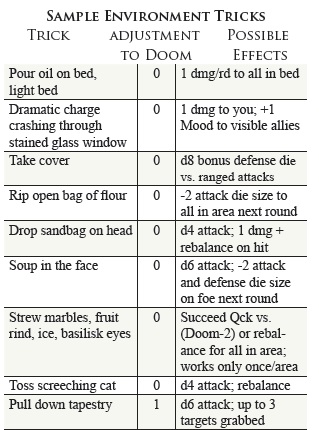
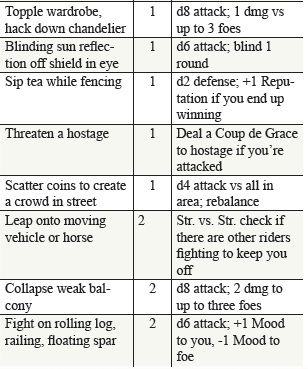
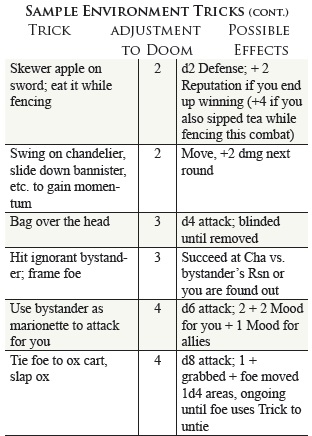
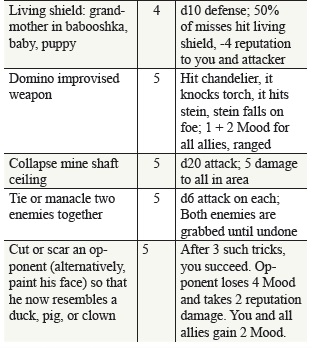
There are a couple of additional rules: basically, if it’s amazing and swashbuckling, the GM should endeavour to say yes, and you raise the difficulty of a trick each additional time in a single combat someone tries to pull it off (to encourage variety).
Armor and weapons are pretty odd in this game, because they have almost no stats. Fighting styles require certain things, but other than that they just have a Quality. Armor absorbs damage - for every two points of Quality absorbs one point of physical (not magical) damage per combat. You can do minor fixes and adjustments after a combat to “restore” those points lost.
Weapon quality is important pretty much only applicable when it comes to weapons breaking, and to penetrate armor. Some of the more impressive armors ignore a point of damage from weapons below a certain quality rating.
There’s a bunch of other stuff: critical hits (when the defender rolls a 1 and the attacker rolls more than half on his die, do two extra points of damage), grabs (when grabbed you can’t move and can only do balancing or grab maneuvers), surprise (when surprised defenders use a d2), modifiers (penalties and bonus dice as per the normal rules), terrain (force people to make checks to do things in some environments, or prevent a full range of maneuvers in others), and coup de graces.
Healing and death is also covered simply. Healing happens in a burst after a combat ends and then slowly after that, you are out at 0 Body (so in effect when you run out of mood and body), and dead at -1 (unless you have an inspiration is high enough).
The chapter ends with a full, and excellent, example of combat. It’s a good addition, and made running a combat for the first time much easier.
Next up: MAGIC
MAGIC (OR HOW TO BLOW UP A CITY BY MISTAKE)
Original SA post SPELLBOUND KINGDOMS PART 6: MAGIC (OR HOW TO BLOW UP A CITY BY MISTAKE)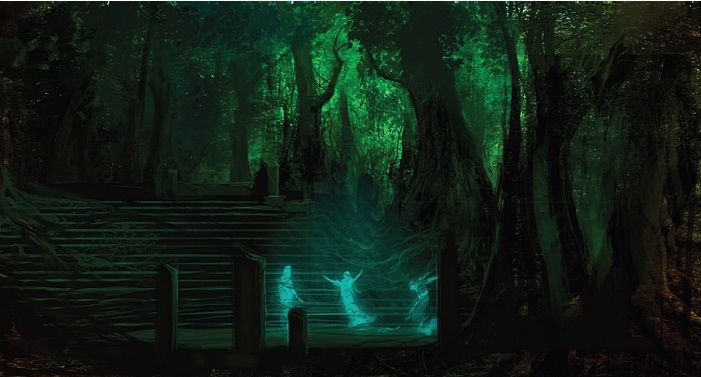
I’m going to let Brunner open on this one:
Spellbound Kingdoms posted:
Magic is the greatest curse and the greatest treasure known to man. It is a force of nature, and a wild one. With no cause or warning, it can burn down a city of 10,000 people or sicken every first born son in a kingdom. People fear magic. People resent magic.
Yet every day, men risk death for spells. A single spell can save a life. There is a saying in the Kingdoms: “Hate what you love.” They say that the High God teaches us to mix our emotions, to dilute love with hate so that neither emotion becomes too strong. Emotions contain powerful magic, so we must keep our emotions weak to limit any collateral damage their magic causes.
But when it comes to magic itself, “Hate what you love” does not mean what the priests mean. It means that people love magic, and they hate magic, both so strongly that the two emotions do not cancel out but roil and intensify, tearing apart whoever dwells too long in the arcane shadow. Magic leads to madness.
Magic in Spellbound Kingdoms is phenomenally powerful. In general, there are no limits on how much of it you can use. The checks to use it are usually pretty easy, and there’s no mana, or Vancian recovery of spells. Wizards are phenomenally powerful individuals.
But magic is insanely dangerous. In some ways, it makes 40K psykers looks like solid and reliable individuals.
There are two kinds of magic: natural and artificial.
Magic is an intrinsic part of the world of Spellbound Kingdoms, and natural magic occurrences are relatively common. There’s some good information on this:
Spellbound Kingdoms posted:
Magic events on a minor scale are uncommon. In a town of 10,000 people, roughly one minor- to medium-scale magic event occurs each week. These events are almost always destructive. They might be a magical disease striking a young woman, all the glass in a church’s windows suddenly shattering, or all the cheese in a fromagerie deliquescing. In a larger city, something like this happens somewhere every day.
Magic events on a larger scale are rarer. In a town of 100,000 people, a larger event happens on average once per season. This could be a town park getting wet as if it were raining without anyone actually seeing rain; a statue tumbling prone, dragging itself through the dirt to a crossroads, and then speaking in a language no one knows before reverting to lifelessness; a blacksmith shrieking and turning into a six-legged, carapaced beetle freak who attempts to devour his apprentice; or the landlady discovering she is inexplicably and irresistibly in love with the old man who rents a room from her.
Approximately once a decade, somewhere in the known world, there is a magical cataclysm. These events are bizarre and catastrophic. All the males in a city might fall into a coma for fifteen years. Doubles of every person might be spawned in a city fifty miles distant. Tentacles might sprout over a village and drag it underground to a fate unknown. A dragon might become intelligent.
You read that last one right. Setting tidbit: 99% of dragons are basically big dumb lizards. The handful that are intelligent are that way because they were hit with magic.
The other kind of magic is artificial. Those who can cast spells, magical creatures and even powerful mystic items are all spellbound. They have a unique magical “frequency” that is what allows them access to their power, and that frequency is sensitive. When two or more spellbound entities are in the same vicinity and one or both of them use their powers, there’s a risk their frequencies interfere with each other.
Mechanically, when you roll a 1 and there are other spellbound creatures or items in the area of effect of the spell (most spells have an area of effect that’s strictly immediate, but… there are exceptions) then a wild surge happens.
A wild surge is where magic lashes out at all the spellbound in the area, and one random poor bastard, causing damage - the more spellbound in the area the more damage it causes. In a room full of wizards a rogue spell might literally kill them all. The damage is caused by rogue magical effects, and some unusual surges might rip out memories, damage minds and so on. Basically it’s bad.
It can get worse. If a spellbound rolls a 1 when they try to resist then the interference has caused a tidal wave of further interference. The surge meets another surge and then the whole thing… cascades. That’s when there’s a crisis surge.
Spellbound Kingdoms posted:
A crisis surge occurs when a wild surge critically hits. Crisis surges are the largest single reason that people throughout the Claw fear and despise magic. When a crisis surge occurs, almost anything can happen.
The GM narrates the effects of a crisis surge. The effects may be nothing more than a ringing in the ears and a point of Mood damage. Or they could be a volcano erupting, a spellstalk plague, a princess cursed to a thirty-year slumber, a second head - be creative!
There are ways around surges. Apprentices and their masters can purchase a talent that means that their magic doesn’t interfere. Cabals can gain a cabbalistic casting power from being part of an Arcane Order. Other that that you’re left to cope - that’s why wizards live in tall towers and away from population centres.
When you learn a magical style you learn it as a neophyte, an apprentice or a master, just like a combat style. In combat that works exactly the same - you either have balancing (called re-casting for magic) maneuvers and a couple of extras, all but the mastery maneuvers, or all of them.
Out of combat there are two types of magic: Close and High spells. Close spells only draw on the immediate area for their power, and are limited in effect (but still quite potent). A neophyte only knows two close spells from the list of that style, while apprentices know all but the ones marked as a mastery spell, and masters know all of them… and can cast them as much as they like. The spells are pretty cool, and vary from the simple but useful:
Spellbound Kingdoms posted:
Repair. You can repair simple objects with no interior structure and no complicated moving parts.
To the potent:
Spellbound Kingdoms posted:
Listen to the Same Stars. After listening to the stars for a night, you learn the name of the most powerful organization in the region and have a vision of one of the organization's recent actions.
Close spells can also be cast freeform - there are some guides on that, but it’s mostly in the GM’s hands. They can only be attempted by a master.
And then there are high spells. Most high spells have a much larger radius of effect than close spells, and that means they’re very dangerous. They’re also insane.
Spellbound Kingdoms posted:
Vortex. An arcane twister roars through the region along a path you specify up to half a mile long. Anything alive and touched by the vortex is transported elsewhere. Creatures aware of the vortex and attempting to avoid it can make a chase roll against the Doom (or, if appropriate to the game, run a Chase scene against the vortex). Determine the destination of those caught in the vortex by rolling percentile dice.
1-10: Bottom of nearest major body of water.
11-20: Bottom of the nearest dungeon, prison, or school.
21-35: Nearest enemy's courtyard, orchard, lists, peristyle, docks, or similar.
35-50: Heart of nearest magical beast's lair.
51-65: Nearest active battleground.
66-75: Altar room of a Low God cult in a land at least 3 days journey from here.
76-80: Same spot, one week in the future.
81-85: Inside a sarcophagus in a royal tomb.
86-90: Top of the canopy in a royal bedchamber.
91-95: Ally's home.
96-00: Home.
Oh and
Spellbound Kingdoms posted:
Hush. You steal the voices of every person living in an area the size of a small town. The voices are placed in a puzzle box, cameo locket, or corked bottle. Only spellbound creatures have a chance to resist by rolling their Magic against yours. The town silence continues as long as you maintain the box, locket, or bottle, which counts as your trapped high spell. If the voice vessel is broken, all voices are returned and cannot be stolen again for one year.
and
Spellbound Kingdoms posted:
Void. After a night of casting with at least two acolytes, you drop a hole out of the magic in an area. One type of Inspiration - your choice - is now unusable in the region. Void persists indefinitely; it counts as your bound high spell. Any wild surge caused by casting this spell results in a crisis surge.
You can only cast one high spell a day.
You can also trap spells in objects: scrolls, potions and candles being the common choices. You can have up to 1 close or combat spell per 3 magic levels trapped at any one time, and up to one high spell trapped at any one time ever, and when you do it you can’t cast another high spell until it’s released. It can be released by anyone by doing the action specified when it’s trapped - reading the scroll, drinking the potion, burning the candle, etc. The released spell uses all the original wizard’s abilities and rolls, but the releaser chooses the target.
You can choose to specialise in one kind of trapped spells (only scrolls or only potions or otherwise) totally unable to trap in any other form, but in exchange you can trap a high spell and still cast another spell.
That’s it for magic. Next up: CHASES (YES THAT’S A WHOLE CHAPTER)
CHASES… AND A SOCIAL SYSTEM THAT DOESN’T SUCK, BECAUSE IT TURNS OUT THE CHASE CHAPTER IS SUPER SHORT
Original SA post SPELLBOUND KINGDOMS PART 7: CHASES… AND A SOCIAL SYSTEM THAT DOESN’T SUCK, BECAUSE IT TURNS OUT THE CHASE CHAPTER IS SUPER SHORTSpellbound Kingdoms posted:
There are many reasons to run in the Kingdoms. You could run for your life, like the thief dashing through the palace with the spell in her pouch and the guards on her tail. You could run for something more important than your life, like the groom on horseback galloping through the canals, jumping bridge to gondola to barge, trying to catch up to the pirates and the abducted bride. And of course you could run a race, like the ice sleds sailing and skidding around the walls of Thyre at the Neverlight Festival.
In summary when a chase happens the GM describes the locale, and then sets a chase difficulty. This is often the doom, but the GM is free to raise or lower it according to the pressures of the situation. Once that’s done, each PC says whether they want to:
- Keep pace
- Push it
- Keep it easy
- Take an action like attacking or dropping caltrops
Then PCs and NPCs take actions. If you keep pace, you just roll against the chase difficulty. If you choose to push it, you roll against the chase difficulty +1, but if you succeed you make up ground (getting closer or far away, depending on the circumstances). If you take it easy, then subtract 3 from the chase difficulty, but you lose ground regardless - it’s best reserved for when failing results in your falling into lava or get hit by a chariot or something.
You can also use environment tricks as you would in combat, which adds a nice element of flexibility to your actions.
Whelp, that’s all I can say about chases. The rules are good, but there’s not a lot else to say. I get the impression the reason it had a whole chapter was that there wasn’t anywhere else obvious to put it.
Oh yeah, there is a really good example of a chase! I like all the examples, it really helps with putting this stuff into effect.
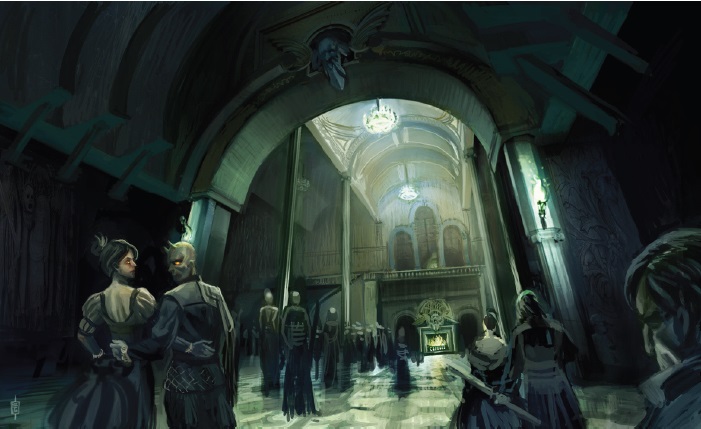
So social! While not as in depth as the physical combat system, the social engagement rules have a lot of support. Since mood is the defining statistic stopping you from dying, social damage takes on a whole new level of lethality - intrigue can turn deadly, stripping you of mood and leaving you open to inspiration loss or actual bodily harm.
Broadly, social attacks use Charisma and are resisted in kind, with histories and skills adding into the mix smoothly. We should also probably talk about reputations, since this is the venue in which they really kick in.
Reputations are very similar to histories, adding dice to checks where they apply. They measure how others perceive you, and you gain and lose them pretty fluidly in play. Negative reputations are also a thing, and can act as penalty dice on checks (particularly social checks).
Just like with physical combat, you can make a critical hit with a social attack.
Another neat thing in these rules is how they handle secrets. If you know a secret about the person you’re targeting with the attack you can reveal it to increase the attack three die sizes - but just the once, of course.
So, we know how social combat works, but what about social weapons and armor? High fashion is the answer, with it granting bonuses to attacks and defenses according it its quality.
There are some neat special attacks:
Spellbound Kingdoms posted:
- Disarm. Clothes and other conversation pieces can be “disarmed.” Make an attack as normal; if you succeed, your opponent cannout use that item until she gains a Mood point (either through an effort of her own or someone else).
- Power attack: Your attack is emotional and illogical, but if it hits home, it hits home deeply. You decrease your attack die by two sizes, but if you hit, you do one extra point of damage.
- Mood Lift (Schadenfreude). If your social attack hits, you may forego causing Mood damage to your opponent. Instead, you gain a point of Mood yourself.
- Narrated attack. You can narrate action that allows you to use a characteristic other than Charisma for your social attack or defense. A card trick that embarrasses your host, or a flex of your muscles at the young noblewoman, and you can use Quickness or Strength to make a social roll. The GM is encouraged to limit de facto the use of Narrated attacks to one or two per scene. Charisma is the primary mover in social encounters, and Charisma-based characters' investment is to be protected.
- Smear. You drag someone’s name through the stalks. After your social attack hits, instead of losing Mood, he loses 1 reputation. Someone from the relevant reputation group must be present; if a tree falls alone in the forest, it doesn’t lose reputation with the rose bushes in the city.
- Self-aggrandize. If your social attack hits, instead of doing Mood damage, you gain 1 point of reputation with one group that is present.
There are some neat ideas on improv social scenes and how to run them too - there’s some good stuff in there.
It’s jumping ahead a little, but let’s look at the social equipment:
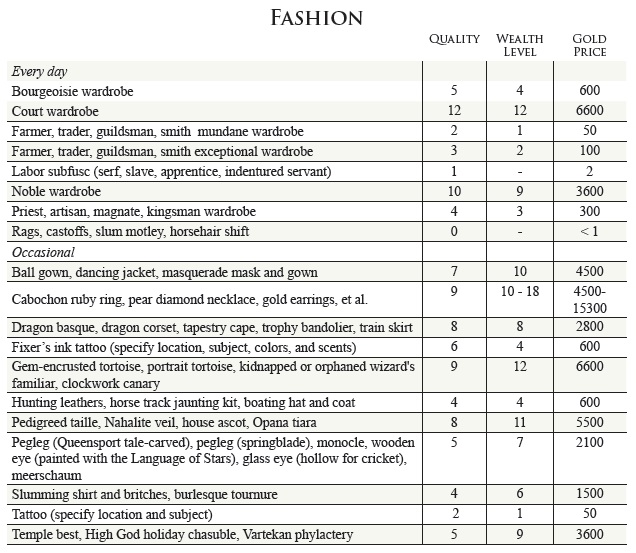
A lot of these things do cool stuff that’s not as simple as their quality. My favourites are pets:
Spellbound Kingdoms posted:
Tortoise, familiar, canary. You can always stare at your pet (your fashionable pet!) and pretend not to have heard someone's biting remark. In any round in which you use your fashion pet, you can ignore a point of social damage. You may use your pet once per scene. The pet must be fashionable; no one brings a hound dog to a coronation.
And tattoos:
Spellbound Kingdoms posted:
Tattoos. A tattoo has double its quality when first revealed: a fighter ripping his shirt off to reveal a death's head inked on his pectorals, a woman raising her dress to expose the ink on her thighs, a forbidden sigil tattooed on a disciple's scalp under hair that must be shorn before the tattoo is visible.
That’s all on chases and social encounters. Next up: WAR. HUAH. WHAT ARE THESE RULES GOOD FOR? TURNS OUT QUITE A LOT.
WAR. HUAH. WHAT ARE THESE RULES GOOD FOR? TURNS OUT QUITE A LOT.
Original SA post SPELLBOUND KINGDOMS PART 8: WAR. HUAH. WHAT ARE THESE RULES GOOD FOR? TURNS OUT QUITE A LOT.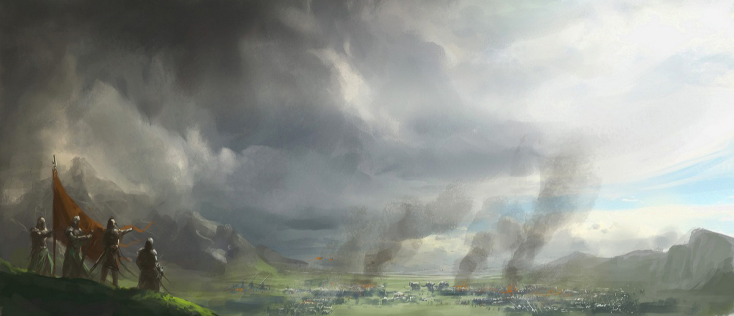
Spellbound Kingdoms posted:
War never changes.
Oh yeah, we went there.
So, in short war can be handled in two different ways: abstract and actually playing out the battles.
In abstract mode the battles (or entire wars) are fought in the background of the campaign, but not through GM caveat. Instead such engagements are resolved by contested organisation checks (we’ll come onto organisations in a later entry), with the outcomes narrated by those controlling the organisations. Again, there’s an example which makes the whole thing much clearer.
If you want to actually play out a battle (and the book suggests you could use the abstract method for resolving the opening conflicts and then actually play out the climactic clash) then you have a whole new suite of rules available to you, which are functionally similar to personal combat but with some new ideas and spins on some thing.
Put simply, Chapter 6 of Spellbound Kingdoms is a complete fully functional war game.
Brunner is insane.
Armies are divided into units. The smallest kind is the troop, which is recruited as one group and cannot be usefully broken down further. A troop can range from infantry with dozens of members to mammoth cavalry with just ten mammoths to a fucking dragon on its own. Roughly, all of those things have more or less the same combat effectiveness - the 75 pikeman are roughly equal to 10 mammoths are roughly equal to a not terribly powerful dragon.
Brigades are two or more troops combined who receive orders, from up and maneuver as if they were a single unit. There are some rules on “stacking” troops into a brigade, and basically the increased numbers just increase their effectiveness rather than giving them additional attacks and so on. There are other rules for stacking siege weapons, and how to disband brigades in combat and so on.
Each troop is capable of being in a number of different formations, and each round of a battle you can reset a troop’s formation. Formations are a lot like personal combat styles, and while in a formation you may have access to a number of maneuvers - these cost you “command points” to activate, but are quite powerful.
Command points are a measure of your ability to communicate with and control your troops. Basically, a PC being in charge of an army generates a small number of command points, but class levels, class abilities, talents and magic can all grant more.
Command points are allotted in secret at the start of each round and are used to do a bunch of different things including moving units to new areas, executing maneuvers, creating or breaking up brigades and rallying troop.
Each formation and maneuver lists attack and defense dice, and you use these as you’d expect. Damage hurts the health of a unit, but units also have spirit, and some formations and maneuvers hurt the spirit of your targets - if they drop to 0 health, the unit is wiped out, if they drop to 0 spirit, they break and run (though you can try to rally them).
One neat thing that’s included is the concept of secret troops, allowing you to use scouts and infiltrators to spring surprise attacks on your opponent, and forcing your enemy to waste time hunting for them. It’s neat, simple and effective.
Heroic actions are of course a thing in battles - PCs can leave the command structure to go off and do heroic things, like challenging people to duels, opening parleys and completing specific missions. You basically play this out as short scenes that then have an impact on the units in the battle.
There are pretty good rules for terrain and weather, which are mostly expressed in this table:
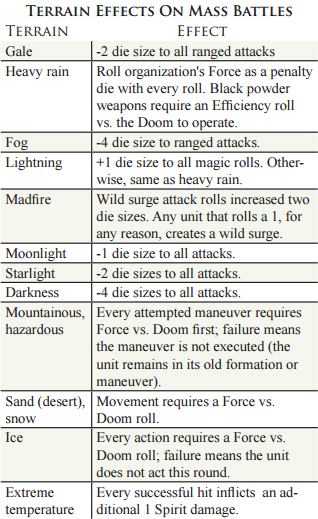
Moving around the battlefield costs command points, but otherwise works as personal combat does (with areas), though there are some extra rules about moving into an out of areas with enemy units in it, and some nice exceptions for hidden units.
Oh, yeah, it’s worth pointing out that magic surges are still 100% a thing in battles. You didn’t think it would be that easy to get away from it, did you?
Spellbound Kingdoms posted:
Crisis surges are possible and probably catastrophic.
There are then a few rules about how long battle rounds take (as long as you like, mostly, as long as everyone agrees), how units recover after battles and how to escape a battlefield.
There are some decent rules for buildings and sieges, and how siege warfare works, and for starving out fortifications. There are also some impressive rule for how to determine the aftermath of a battle, the effects on each side and the organisations they represent, and even the economic and social effects of warfare on a region, with solid mechanical impacts.
Finally in this chapter there’s a section on shadow wars - secretive wars of sabotage, assassination, blackmail and other nefarious activities between thieves guilds and secret societies. The rules play off the rules for battles, and also the organisation rules, and are actually really good. I’ve never seen treatment of this in the same light as open battles in a RPG, and it’s an impressive addition.
That’s the end of the chapter, but I think it makes sense to jump ahead a bit and look at the available troops before wrapping up.
Troops are attracted either by being paid a certain amount on a fortnightly basis, or by attracting them as part of your wealth level or that of your organisation (we’ll see more about wealth levels in the next part). There are a lot of troops on offer:
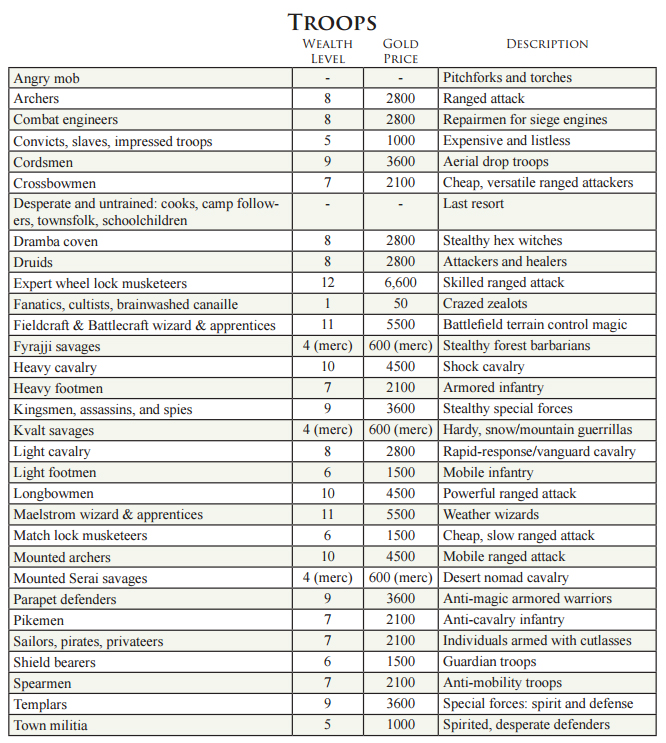
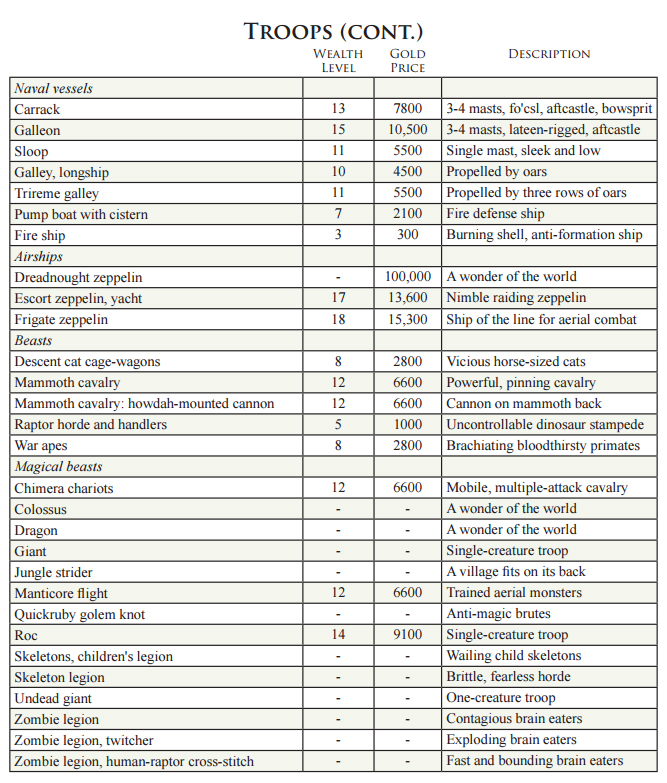
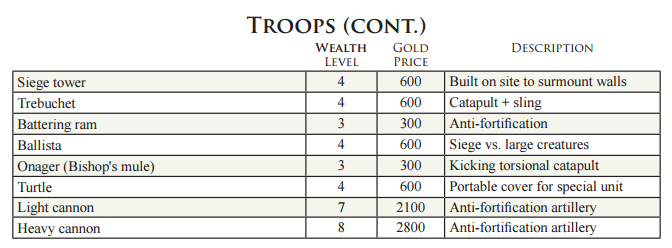
Each of the troops has their own set of formations and maneuvers, and their own special rules. Here are a few to give you a flavour:
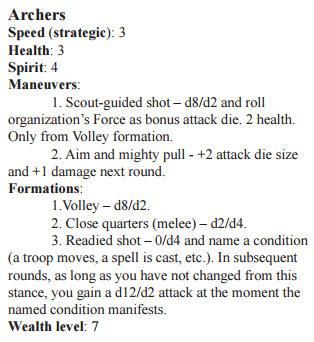
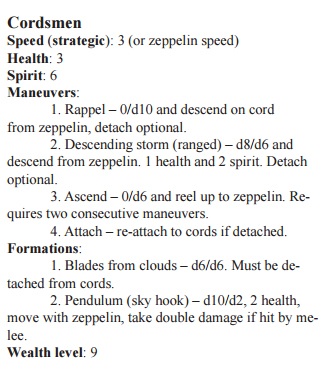
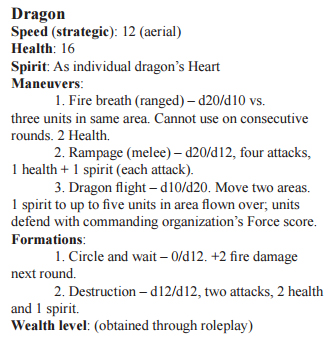
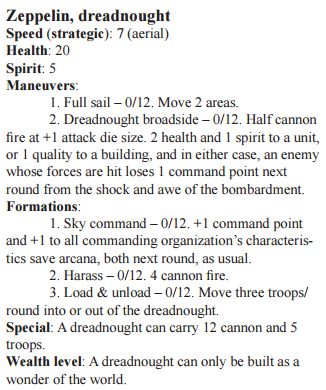
Next up: WEALTH AND A WHOLE BUNCH OF RULES THAT ARE IN THE CHAPTER FOR NO EXPLICABLE REASON
WEALTH AND WORLD
Original SA post SPELLBOUND KINGDOMS PART 9: WEALTH AND WORLDThis is a little bit of a strange chapter, as it sort of wedges in a lot of rules that presumably Brunner couldn't find anywhere else to put.
It opens with an examination of wealth, and explains how spending money works and also how Wealth Levels function. Basically, Wealth Level is an abstract representation of income, the ability to take out loans, holdings and the ability to convince others to chip in. It’s sort of a measure of social standing as well as economic standing.
Basically, everyone starts at wealth level 2, and it goes up to 20. You can own a bunch of items at your wealth level and a bunch more at each level below for free, and replace them when you lose them (though doing so takes about a week). That means you can have a decent spread of kit without having to worry about things too much. Also, because troops, buildings and other things like that all have wealth ratings, you can swan around on your own personal Zeppelin if you’re rich enough.
There’s also actual gold coinage too, which you track and get and spend. You can invest gold to raise your wealth level (equal to current wealth level x 1000 gold to get to the next one). Once invested, the gold is gone, so there’s a balancing act between getting the odd bit of nice kit now, and saving it for future prosperity. You’re basically buying into social and economic standing, and risking it (since other people can attack your wealth levels socially in some cases).
Spellbound Kingdoms posted:
A Wealth Level 10 character may receive an invitation to the archbishop's ordination or the Baron's polo match, but a Wealth Level 2 character never will. On the other hand, enemies have an easier time destroying a character's wealth if it is represented in Wealth Levels because they can attempt blackmail, arson, embezzlement, and other crimes beyond theft.
You can drop wealth levels voluntarily to “cash out” and get half of what you invested back. That can be useful in a pinch, but the book makes clear that it’s rarely a good idea, and instead recommends that you look at investing your money in something that makes a profit instead (we’ll look at that later on).
There are then some rules for selling items, the cost of living, a formula for working out how much it costs in gold based on an item’s wealth level and a discussion of coins and coinage. Gold coins are named by kingdom (kings, crowns, suns, dragons, etc) while silver are usually called moons and copper called dirts. It indicates you shouldn’t ever have to worry about such trivial coinage.
There’s then a neat little section about economies and fluctuating prices, with some guidance on how they should change and why. There’s also a neat table on wealth and social class:
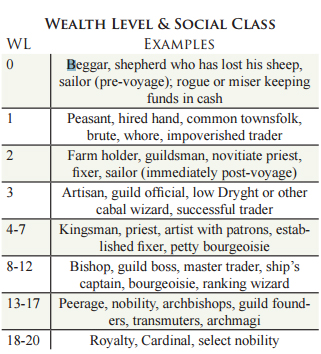
After the discussion of wealth, Brunner moves on to culture. Each region in Spellbound Kingdoms has three “culture lines”. Each culture line is basically a short statement which describes what people in that region fear, value or practice. In most cases the royalty sets two of them, and most powerful local organisation sets the third.
That means that royalty have vast power over people, because these culture lines aren’t just flavour, they have massive mechanical effects. For an example, here are one of the major setting city’s (Rithaign’s) culture lines:
Spellbound Kingdoms posted:
Royal: Beauty is fleeting, shallow, cheap, and hateful. Anyone with an Inspiration valuing beauty or art has his maximum Mood lowered by 1 while in the kingdom.
Royal: Beauty, especially in art, is the highest, most noble pursuit possible in this life. Anyone who does not have a skill valuing beauty or art has his Mood lowered by 1 while in the kingdom.
(Yes, the two royal culture lines are selfcontradictory. Lucius has intentionally established a culture that drives people to practice skills in which they find no Inspiration, probably because he is mad, sadistic, or both.
Rithaign: Rithites love adventure. Anyone who has completed what can be considered "an adventure" boosts all existing positive reputations by 1 while in the city.
If all of your inspirations match the culture lines, then your maximum mood increases by one because you’re “home”. If they clash badly, genuinely opposing them, then max mood drops by one per clash. That makes a huge difference, and I'm not 100% sold on this rule to be honest - it might be one of the few things I’d house rule in this game. It just seems harsh.
Changing culture lines is a pretty monumental task, but it’s possible: revolutions, major cultural shifts, propelling an organisation to the heady heights or finding a chosen one of prophecy and getting them to where they need be (Chosen One is a character class).
That done Brunner moves on to a really odd hodgepodge of rules and pieces of advice - how to help get players out of research dead ends, how to help pacing, a few mentions of organisations (though they get their own chapter later on), and a bit more detail about reputations and how they work.
That out of the way, there’s a weird shift of tone and focus, and we suddenly start learning about disease. There’s a simple infection system, but it feel pretty unnecessary… until you hit magical diseases.
Every one of these is gold, bluntly. Spellstalks are magical infections that slowly turn people into a tentacle monster, and Brunner gets bonus points for using the term “desquamates”. Madfire is terrifying, causing roaring infernos of flame whenever a wild surge occurs, and driving the character mad. Blink makes parts of you blink in and out of existence until you completely fade away. Abynder akkas causes your most treasured secrets and inner thoughts to be written on your skin. Drain mystically drains your mood, and makes you an undead magnet.
Next up are some rules for common disasters, from earthquakes to floods to rains of frogs. There are rules for what they do to regions, and how the heroes can survive. There are some… odder ones too.
Spellbound Kingdoms posted:
Faces like pillars of light. Scholars do not 62 understand why this bizarre disaster is so frequently associated with crisis surges. This disaster transforms everyone in the region who fails a Magic roll against the Doom. A transformed creature loses his face; where it once was, a beam of light shoots forth. The beam projects an image in the manner of a masked spotlight, and it is powerful enough to put the image even on clouds in a night sky. The image might be dragons diving, or a burning witch, or a freak hatching from a cracked skull. An afflicted creature takes damage equal to the Doom. The GM or an instigating player selects the image.
Spellbound Kingdoms posted:
Glass. Buildings and characters begin to turn to glass unless successful on a Quality or Magic check against the Doom. The vitrification takes seven days. Each day, a new body part or building area vitrifies, but each day allows a new Quality or Magic check. Vitrification of a body part must be taken as a maiming, taking the place of one history item. If the eyes are cut out of a fully vitrified man, then for a day afterwards, no matter how far away they are taken, what they see appears as an image in the glass of the eyeless body.
Deprivations, breaking objects and simple crafting rules are then covered. The crafting rules are… surprisingly tame and dull for the rest of this book, but they don’t look bad as such.
Finally experience gain is covered - after each session you get one or two history points, which are worth more if you spend them on something that you did in play. After every second or third session you gain an experience level instead.
Next up: CHARACTER CREATION, RACES AND CHARACTERISTICS
CHARACTER CREATION, RACES AND CHARACTERISTICS
Original SA post SPELLBOUND KINGDOMS PART 10: CHARACTER CREATION, RACES AND CHARACTERISTICSCharacter creation is pretty simple:
Spellbound Kingdoms posted:
I. Choose species and race.
II. Assign chracteristic scores.
III. Choose a class.
IV. Choose one history or skill
V. Choose what inspires your character.
Species and race is an interesting one. There are two (consistently) intelligent species that exists in Spellbound Kingdoms - humans and trolls. The author remarks that
Spellbound Kingdoms posted:
Other intelligent creatures exist, but they are singletons, sterile freaks of magic: a cranky aspen, a riddling weasel, a man gone to spellstalks.
Which is probably my favourite sentence in the history of the English language.
Trolls come in two flavours: rain trolls are a bit bigger than human beings, tend to be blue or green, and sometimes have horns and/or antlers; Seradynn are smaller, more human looking in skin tone and have small horns (and occasionally prehensile tails).
All trolls can regenerate at least a little, and there’s excellent information on roleplaying then, with really good explanations and suggestions. There are also suggestions about what classes are good to play with them, and some of their history.
Rain trolls have been around basically forever, are very calm and confident, and have a body part that can function remotely (so you can pluck out your eye and leave it somewhere to spy on people). They also get a slight edge in histories, since their start at d6 rather than d4.
Seradyn are… well… uh.
Spellbound Kingdoms posted:
The seradynn arrived forty-eight years ago, in living memory for some in the Kingdoms.
The first discovery took place aboard a caravel named the Windsnare. The discovery was a troll foot, wrapped in cheesecloth, in a crate of bacon forks destined for the table of a tycoon of far Oryn-ja. The stevedore who unwrapped the foot did not know what to make of it.
Contrastingly, the foot knew exactly what to make of itself. Namely, a new troll. It twitched out of the shocked stevedore’s hand and began an awkward toecrawl toward a pottery crate. Out of that crate flopped a troll leg. The foot and leg attached. Then they knee-inched to a wine barrel, where a one-armed torso hauled itself over the rim and assembled itself with the footleg. And so on. Other stevedores watched troll bodies reform all across the Windsnare.
The same events played out everywhere in the harbor of far Oryn-ja that day. Not a single regenerated troll knew where he had come from or why he arrived dismembered and scattered in cargo holds. The origin of the seradynn remains a mystery to this day
So that’s a thing. An entire species who were mysterious delivered in packing crates.They’re suspiciously magical and also get a body part to detach.
Humans are just humans, bog standard normal… nah I can’t even keep up the pretence. This is Spellbound Kingdoms. Humans are fucking insane.
All of them get a bonus to heart, which is cool, and then there are four races.
Ninebloods are the most common, and are basically “paneuropean”. They’re the classic fantasy human, and probably the dullest of the lot. They can use one inspiration twice in a scene instead of once.
Islanders live out on the Ephemera and Dragon Islands in the far east, and basically have to survive all kinds of insane bullshit - cyclones, volcanoes, madfire, undead, and lots of other stuff. They’re basically hammered into being pure badasses by this experience, and are basically Fremen from Dune. They can lower the Doom of a check by one for themselves or someone else, once per scene per person. They don’t have to spend any time doing that, they just do it.
Wights are descended from a group of people who changed their nature by seeking power, immortality and the dark arts. They live longer than other humans, can sense fears and use other people's’ fears as inspirations, which makes them lose mood. They’re a bunch of goths, basically, and spend a lot of time being ostracised from society and hanging around in moody forests in thunderstorms.
Finally there are the Princes and Princesses of Wolves - children abandoned in the wilds and raised by wolves.
Spellbound Kingdoms posted:
Why would a mother do this? If you lived in the Kingdoms, you wouldn’t have to ask. Kings are not kind to children. Children dream, and hope, and love. The kings teach them how wrong this is, how unbridled inspirations can have disastrous consequences. Their lessons are not gentle. The lessons are wicked enough that a tradition has developed, fervently denounced by the monarchies, that if the stars are the right color, and the season is right, then when a mother lays her babe down on a bed of moss and ferns in the forest, or rubbish in the alley, magic can save the child. The tradition says that a pack of wolves, or perhaps wild dogs, awakens to intelligence, and runs with the child, keeping it safe from kings and cruelty.
I just can’t imagine reading this as a standard race choice in any other fantasy RPG. It’s just nuts. One of the instructions for creating a character of this kind is to
Spellbound Kingdoms posted:
Describe your pack. Name the wolves, sketch their personalities, draw a map of their hunting grounds, talk about the way the pack smelled on cold mornings and summer mornings and after crossing a river. Talk about memorable hunts, favorite prey, and pack enemies.
What the shit Brunner? That’s amazing, but totally ridiculous. Basically they can loan an inspiration to someone else once a scene, which is cool. But not as cool as being raised by wolves.
So we finally get to characteristics! There are six of them: Strength, Quickness, Reason, Charisma, Magic and Heart. You get a spread to assign to them of 4, 5, 6, 6, 7, 8 at character creation, and you assign the largest die you can to each as with histories and reputations and so on. Characteristics max out at 12, unless you’re a dragon or something (you might get to be a dragon later on).
Brunner outright comes out and says you should have a high Heart score, since that sets your maximum mood and is vital to using inspirations (it’s the bonus die you roll when you use them).
Health is the final part of this chapter, and is split into body, mood and reputation. We’ve talked about all of these before, so I won’t spend more time on them now. Body starts at 5 for everyone (and raising it isn’t easy).
Next up: CHARACTER CLASSES (AN INTRODUCTION AND FROM CHOSEN ONE TO FIXER)
CHARACTER CLASSES (AN INTRODUCTION AND THE CHOSEN ONE)
Original SA post SPELLBOUND KINGDOMS PART 11: CHARACTER CLASSES (AN INTRODUCTION AND THE CHOSEN ONE)It turned out I didn't have as much time to work on this right now so I’ll cover the other classes mentioned in the next part - want to get it up before I head out.
Characters in Spellbound Kingdoms belong to one or more classes of character. As the book calls out, the choices within a class are often more important than the class itself, and there’s a good amount of flexibility in there. The classes are:
- Chosen One
- Engineer
- Fixer
- Noble/Priest/Courtesan/Courtier
- Rogue/Assassin
- Savage
- Trader
- Warrior
- Wizard/Witch
Each character class determines what kind of styles they have and at what level, the number of talents they get at each level, special class abilities and some characteristic increases to go along with it.
Because the tables show what your character should have at each level rather than showing what they gain, it’s super easy to multiclass - just read off the line for the level you have in each and note everything down. You use whatever talent table is best for you.
There is a kink in multiclassing, and it’s a very clever one - name level. The different levels of a class have different titles, and one of them is the same as the character class - that’s the name level. If you choose to take a level in a new class before you've reached name level in all your current classes, your maximum mood is cut in half and you take mood damage at the start of each day.
It seems harsh, but it’s actually a very clever balancing act designed to reign in some combinations and push people to others. Those combinations aren't just about mechanical balance either, but thematic. They encourage the kind of stories that Spellbound Kingdoms is really trying to emulate.
I'm going to tackle each character class in turn, with a bit of detail on each and (if I've seen them in play, which I have most of them) how they actually play out.
CHOSEN ONE
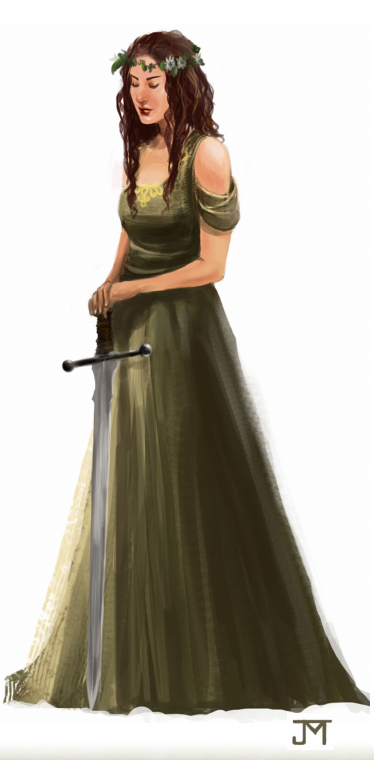
The Chosen One is one of the quirkiest and most interesting classes in the game, in my opinion, and satisfyingly fills a niche that many other games aim to tackle but fall short on. In effect, the chosen one is the hero of prophecy, the farm girl turned divinity, the lost king, or whatever “from humble origins to legend” trope you fancy playing around with.
Chosen Ones are very flexible (almost as flexible as the Noble class, which is impressive in its versatility), and can choose to be magical or martial in their approach. When you choose your first style its type fixes your levels to be one or the other - so make sure you pick what you want to start! That said, you can still choose styles from magic or fighting, however you like, so it’s not the end of the world if you decide later on you prefer one over the other.
Since this is the first class, here’s the progression table:
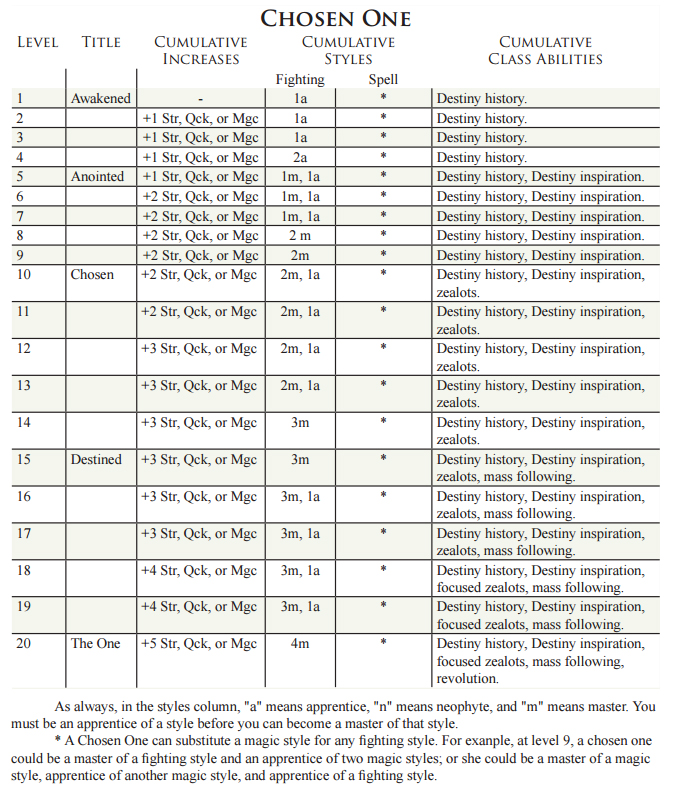
Chosen ones get to progress their attributes in Strength, Quickness and Magic as they progress, and have a steady but not exceptional acquisition of combat and magical styles. They reach name level at 10th, which means you’re locked into the class for quite a while, but honestly, you’re likely to want to stick with it once you get to that point because it really starts getting off the wall from about 15th onwards.
You start off with a destiny history which is basically a bonus history relating to your destiny - the sword you inherited, the prophecy that was spoken about you, the cult that backs you, etc. Once acquired you have to raise it in play like any other history, but you’re likely to do that a lot because it’ll be relevant all the time. Destiny inspiration is basically the same, but with an inspiration (surprise).
Zealots are just what you might expect - a bunch of crazy obsessives who follow you around and do whatever you wish. They’re not exactly smart and tough, but they’ll die for you in combat and get can lash out some damage. As you level up, they level with you, and get replaced slowly when they die.
Mass following creates an organisation - an armed legion or secret society that obeys your whim, and if you happen to already have such a thing you get to buff it to hell and back. Also, you get to rewrite one of your home region’s culture lines - that’s a massive deal as we discovered earlier, and makes them seriously potent on a huge scale.
Finally you lead a revolution and things really kick off - any military unit that fights for you gets honking bonuses, and you get to rewrite another culture line, this time one of the royal ones. Basically you’ve utterly changed the shape of the world. In the campaign I ran with a chosen one, they discovered their true heritage, became the high priest of a sky kraken, and then conquered Akra and threw down King Lucius… and by the time they did, they’d already taken control of 90% of the country. Chosen Ones are super powerful at high levels.
Talents start off as marital or magic (as per your levels), and after level 10 can be social. You get talents at a decent rate, but not excessively. Here’s the talent table so you know what they look like:
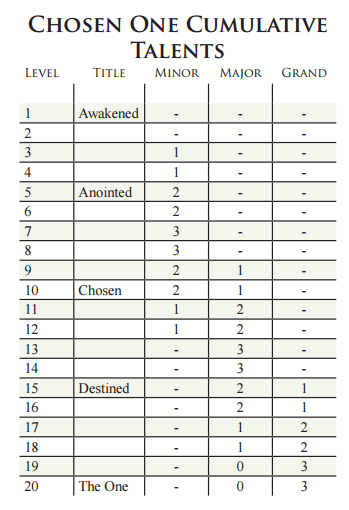
Oh, a last nice touch: if your destiny involves a special object like a shield or a sword, it gains 1 quality per chosen level so you’ve got a reason to keep using it all the way up to level 20.
Next up: CLASSES (ENGINEER AND FIXER)
CLASSES (ENGINEER AND FIXER)
Original SA post SPELLBOUND KINGDOMS PART 12: CLASSES (ENGINEER AND FIXER)Next up after the chosen one is the
ENGINEER
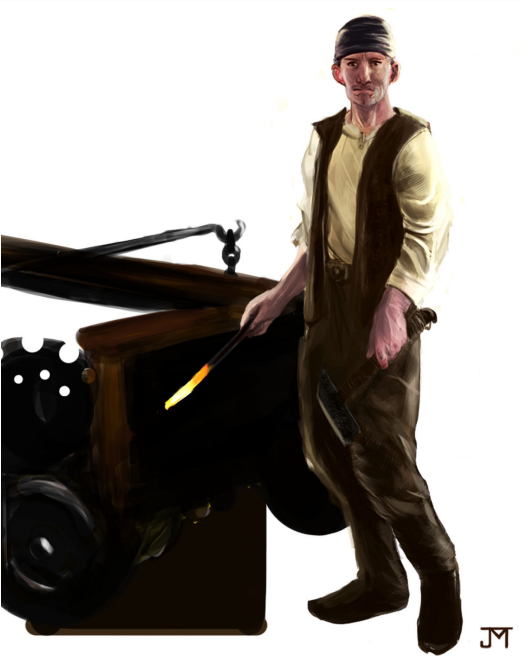
So, Spellbound Kingdoms is broadly an age of enlightenment setting, and that means that there’s some focus on technology and how it’s changing things. It is still a fantasy game though, so that technology is in the shape of Zeppelins and grappling hooks.
The Engineer is the king of ridiculous technology. Their very first class power is Engineering, which just adds 1 bonus point per engineer level to up to three Histories primarily focused on engineering. That means that you hit ridiculous levels of ability super fast, particularly if you’re willing to invest points in them as part of normal play - having a d20 in one or two histories certainly isn’t impossible by the time you’re level 4 or 5.
Engineers also get a signature item - a particular bit of tech that you get to use your Reason with rather than a physical characteristic when you’re doing a trick in combat. It’s a neat idea that makes engineers much less squishy and noncombat than you might think. To put into context the kind of thing you might get with this, let’s have a quick tangent and look at some of the redunkulous shit that you can purchase in this setting.
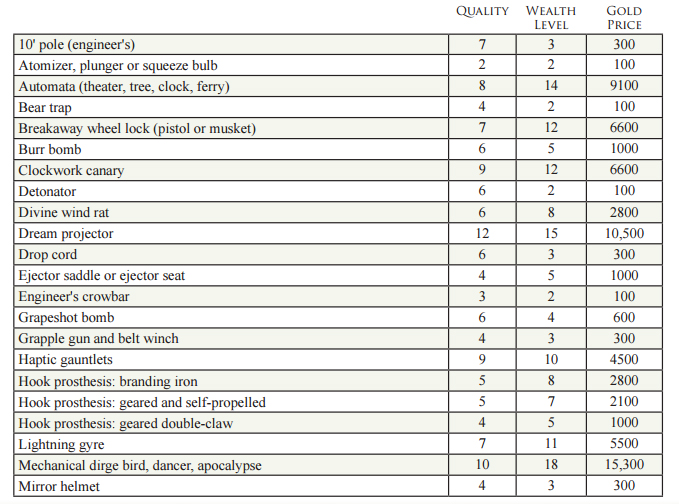
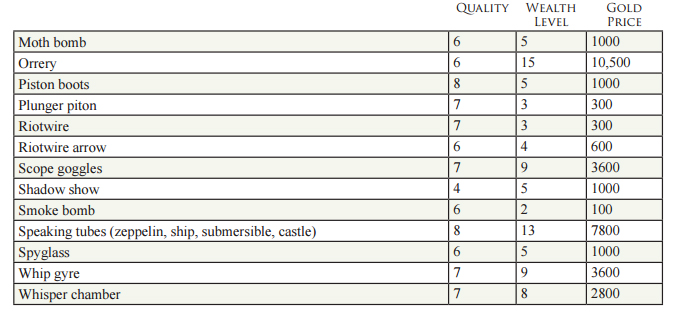
Here are my favourites:
Spellbound Kingdoms posted:
10' pole (engineer's). An engineer's 10' pole, also called a longspoon army knife, weighs 5 pounds and telescopes between 2' and 11'. It contains a periscope for seeing around corners or through dimensional portals. The staff also has thermometers to detect temperatures and thermal gradients along the length of the pole. A sliding bullseye lantern can move between 2' and 10'. Finally, two flint-tipped and three drilltipped grippers form a retractable waldo that grabs with Strength 3 and has the dexterity to write one's name with a quill, spark a fire, or drill a 0.5"-diameter bore hole up to 1 foot deep.
Spellbound Kingdoms posted:
Lightning gyre. This steel sphere pockmarked with teardrop-shaped spigots whirs, sparks, and rotates blindingly fast when activated. The gyre sparks to every character in the area wearing metal armor or carrying a metal weapon (up to 30 targets maximum). If there are no characters in the area with metal armor or weapons, the gyre sparks to five randomly determined targets. It attacks with a Quality vs. Defense roll and does 2 points of damage per strike. The lightning gyre operates for a number of rounds equal to its Quality. You may toss the gyre one area for every three points of Strength that you have.
Spellbound Kingdoms posted:
Piston boots. Pistons in these boots' heels aid your jumps. Roll the boots' Quality as a bonus die on any jump. Unfortunately, your Quickness is reduced by 3 when wearing these heavy boots
Spellbound Kingdoms posted:
Riotwire comet arrow. A riotwire comet arrow spools out multiple coils of riotwire as it flies, leaving behind it a wide tail of razor-sharp filaments. The “safe ends” of the tail wires are simple cable for three or four feet, attached to belt loops on the archer’s belt. This allows the archer to tie off the cable after the arrow has flown. Comet arrows provide a quick way to spread riotwire across an area of up to 100 feet by 10 feet (the most wire that can fit in an arrow capsule).
An engineer with scope goggles, smoke bombs and a grapple gun is basically Batman.
The Combat Engineer ability increases the damage of engineering objects used in combat, so you can make your bombs and gyres do more damage, or make a siege engine more effective. Mechanical advantage lets you treat any item you use as a higher quality.
Engineers also get a boost to histories at 11th, 17th and 19th, making the high level engineer a terrifying powerhouse of skill. At 15th they can start making masterworks, which are basically engineering kit that work way better than normal.
The real earth-shattering skill of the engineer comes with wonders. You can build your first one at 18th level (with the appropriate title of Architect of Wonder) and at 20th you can just build as many as you like. Wonders are truly incredible bits of kit.
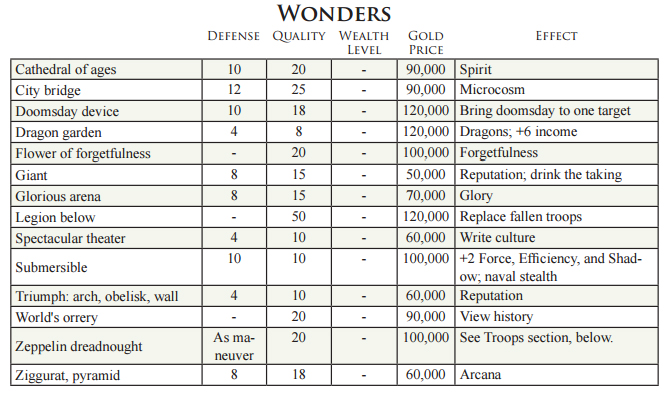
Spellbound Kingdoms posted:
Legion Below. Fixers and thieves are not the only ones who use the underworld. A king who has constructed a Legion Below has thousands of terra cotta soldiers prepared to animate and swell the ranks of his forces. The Legion Below cannot move of its own power before being brought to life; it must be transported. It is the equivalent of 5 troops when filling a zeppelin, barge, or wagon's cargo hold. Once deployed, it can negate up to 50 Health damage in a battle by replacing living units as they fall. The Legion Below can only be used once; its clay falls lifeless after the use. The Legion Below is built by an engineer, but the final step of its preparation is to anoint it with two takings (this is similar to the Giant, above). The takings must be the Peace of a warrior and the Faith of a criminal.
Spellbound Kingdoms posted:
Ziggurat, pyramid. Enduring and powerful, pyramids and ziggurats are statements of raw power. Increase your organization’s arcana score by 6 and all maneuver attacks and defenses of spellbound troops and beasts by one die size.
As well as these abilities, they also get bonuses to reason as they progress, and though their combat styles aren’t plentiful, they’re not completely screwed. They become an Engineer at level 5, so they can multiclass out after that. Their talents are martial or shadow (and then social from level 10 onwards).
FIXER
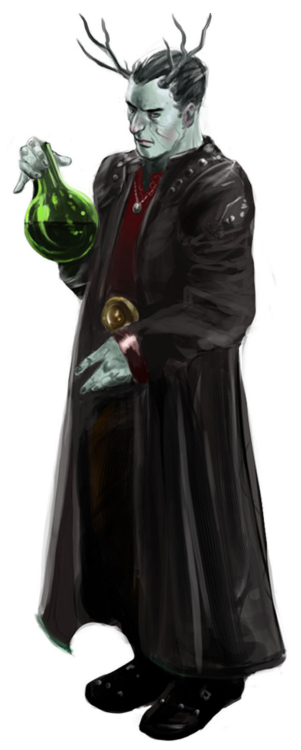
Fixers are something of an odd addition to Spellbound Kingdoms, because though they fit a common trope (alchemist) they do it in a way which is pretty unusual. Fixers are alchemists, sure, but also surgeons, healers, sages… and fences. They’re mostly criminals, operating a fraternity across the kingdoms that serves to preserve centuries of secrets and mystic talents that are not magical in the way other things are magical. A noble might have a fixer on staff, but they would do so in secret, and they’d never be sure that the fixer wouldn’t be looking to betray them.
The most astonishing thing that fixers can do is cancel out magic. They specifically counteract the power which the nobles take for themselves, and because of that they’re hunted and ostracized.
Fixers can, of course, fix - cure any disease, stop any magic or alchemical effect, or neutralize any poison. If your fixer level is greater than the quality level of the item or than the virulence of the disease, you just do it. You have to roll Reason against Magic against spells, but again, if you win, it’s gone, no matter what it was. Fixing someone takes a hours and can only be attempted once a week (so as not to kill the victim), and needs supplies and a laboratory. It’s still probably the most powerful ability in the game, and you get it at level 1.
Fixers also get access to the Fraternity, gaining a reputation with them and access to a very powerful and dangerous organisation, which can assist in tasks every now and then.
They also get the mirror of the engineer’s key ability, alchemy, which gives you a bonus point in three histories per level, and lets you treat any alchemical item you use as being of a higher quality.
At level 9 you get the ability to attempt a quick fix, using the fix ability but in combat as a trick, but with its effects being temporary (you can still spend the time afterwards to fix it properly).
Higher levels allow you to transfuse various substances into a subject, from phlegm which lets you restore characteristic damage to magic juice that turns people into golems. You can also transmute lead into gold, do extra damage with alchemical goods, get bonus history points and, at 20th level, make the Ultimate Solution, which makes you immune to surges and magical disease and gives you massive bonuses to resist magic.
The big draw of fixers is that they can create alchemical goods, and boy, are there some alchemical goods to choose from:
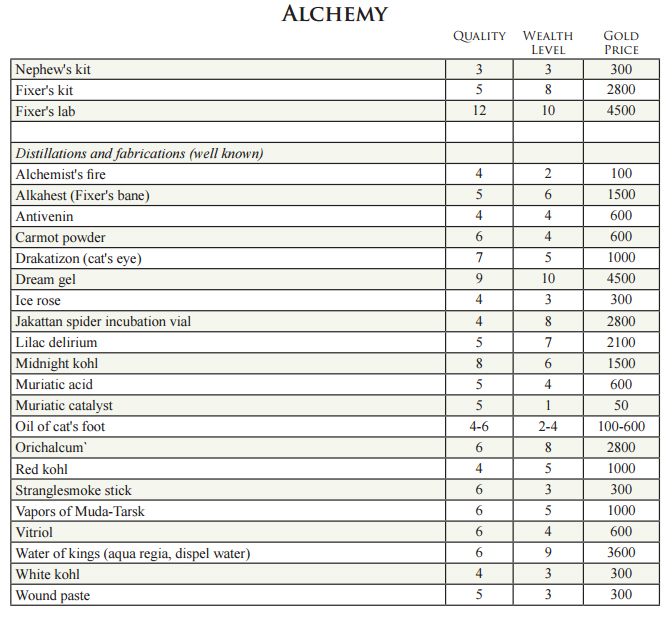
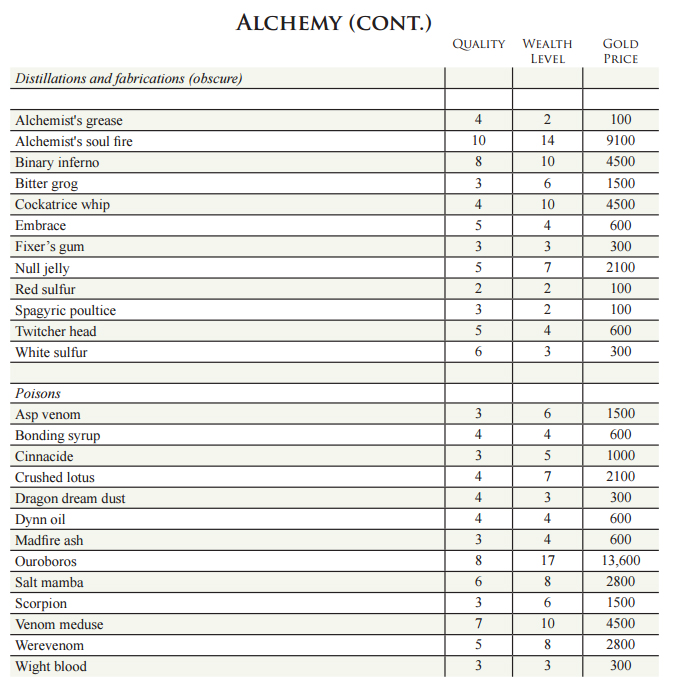
Some of my favourites are:
Spellbound Kingdoms posted:
Twitcher head. A twitcher zombie’s head begins to twitch after being lifted out of its alchemical preserving fluids. It can be pulled from its storage sack and tossed in the same round as a Trick in combat. The next round, it explodes, rolling its Quality die as an attack die against all in the area. It causes two points of damage and exposes those hit to the flake plague (see p. 59).
Spellbound Kingdoms posted:
White kohl. In the Old Claw, white kohl is an ancient art. Each shade, each whorl, is freighted with meaning from centuries of tradition. White kohl performance ceremonies are most common in the long stretch between midwinter and spring but can occur throughout the year. Increase any one of your Reputations by two if, at a significant white kohl party, yours is applied by someone whose skill roll beats the Doom. White kohl wears off after six hours, and it cannot be worn with other kohl.
Spellbound Kingdoms posted:
Madfire ash. Spellbound creatures who eat madfire ash immediately attack anyone around them. The victim tries to cast a spell every round and is unable to distinguish between friend and foe. She attempts to burn everything to the ground. Each round, a new Strength vs. Quality check is applicable.
Fixers can choose talents that are shadow or social, but must always have at least one shadow talent.
Next up: CLASSES (NOBLES, PRIESTS, COURTESANS, COURTIERS, ROGUES AND ASSASSINS)